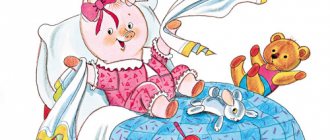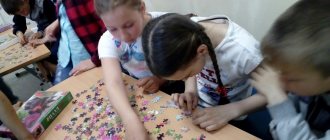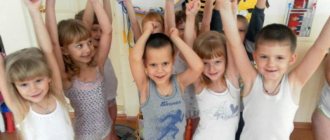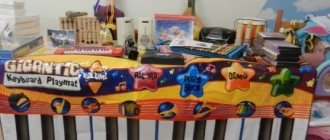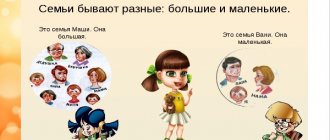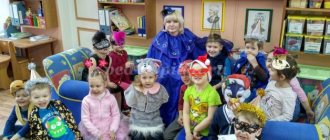Violation of these rules leads to a decrease or absence of the positive effect of hardening, and sometimes to hyperactivation of the neuroendocrine system and its subsequent depletion.
Hardening activities are divided into general and special.
General ones include a proper daily routine, balanced nutrition, and physical exercise.
Special hardening procedures include:
- air hardening (air baths),
sun hardening (sunbathing),
Air baths.
The first hardening procedure for an infant is air baths. It must be remembered that the air temperature in the room for a newborn baby should be 23°C, at the age of 1 to 3 months. — 21°С, from 3 months. up to 1 year - 20°C; over 1 year - 18°C. Infants have high energy costs and oxygen consumption (2.5 times more than adults), so it is necessary to ventilate the premises 4-5 times a day for 10-15 minutes. in winter, keep the windows open almost constantly in summer. Ventilation using a window or transom is carried out in the presence of children; the air temperature drops by 1 - 2°C, which is a hardening factor. It is advisable to carry out cross-ventilation when there is no child in the room. It is possible to use air conditioners and microclimate systems that automatically regulate temperature and humidity.
In the summer, newborns can be taken for a walk almost immediately after birth, initially for 20-40 minutes, quickly increasing the time to 6-8 hours a day.
In winter, children are first taken outside at the age of 2 - 3 weeks at an air temperature of at least -5 ° C for 15 - 20 minutes. and gradually increase exposure to air to 1.5 - 2 hours 2 times a day.
Air baths themselves begin to be carried out in the maternity hospital, when, when changing diapers, the child is left for a short time without clothes. Air baths should be carried out in a well-ventilated room at an air temperature of 20 - 22 ° C (for infants) and 18 - 19 ° C (for children 1 - 2 years old). Initially, the duration of the procedure is 1 - 2 minutes, every 5 days it increases by 2 minutes. and reaches up to 15 minutes (for children up to 6 months) and up to 30 minutes (after 6 months). Air baths must be combined with gymnastic exercises.
Principles of hardening children
Hardening is a serious test for the body, so before starting this process, you should consult with your doctor. The specialist must make sure that the child is healthy - this is an essential requirement for starting classes. In addition, the doctor will provide professional recommendations on the conditions of the procedures (their duration, intensity, etc.).
Parents should remember the following principles of hardening children:
- when hardening, it is necessary to take into account the individual characteristics of the child (including age);
- classes should be regular (you can’t do hardening from time to time - this is a lot of stress for the body);
- hardening should be gradual, without the risk of hypothermia or overheating (you cannot sharply change the temperature and increase the duration of the procedures);
- During hardening classes, it is necessary to monitor the child’s well-being.
If all requirements are met, such procedures bring moral pleasure and physical health. The child sleeps better, has a good appetite, a cheerful mood, increased performance and resistance to disease.
Sun hardening.
Ultraviolet rays actively affect the immunological resistance of the body. However, the younger the child is, the higher the sensitivity to ultraviolet rays. Therefore, sunbathing is contraindicated for children under one year of age. They are prescribed with caution to children from 1 to 3 years of age, and only at an older age they are carried out quite widely. Scattered sunlight contains a lot of ultraviolet and relatively few infrared rays, which cause overheating of the child’s body, which is especially dangerous for children with increased neuro-reflex excitability.
In autumn, winter and spring, direct sunlight does not cause overheating, so getting it on the child’s exposed face is not only acceptable, but also necessary. In summer, it is recommended to carry out light-air baths at an air temperature of 22 ° C and above for infants and at 20 ° C for children 1 - 3 years old, preferably in calm weather. In central Russia, light-air baths are best carried out from 9 to 12 noon, in hotter climates from 8 to 10 am. The duration of the first bath for infants is 3 minutes, for older children - 5 minutes. with a daily increase to 30 - 40 minutes or more. An absolute contraindication to sunbathing is an air temperature of 30°C or higher. After sunbathing, children are prescribed water treatments. Since the body becomes hypothermic when the skin is wet, it is imperative to dry the child, even if the air temperature is high.
Hardening rules
If you are determined to start strengthening your baby’s immunity, you need to act wisely. When choosing the appropriate way to accustom your child to temperature changes, follow a few general rules.
The main thing is attitude! No hardening manipulations should be carried out with an unprepared child. At the very least, the baby will get scared and cry, and you will lose your decisive spirit and, most likely, give up your attempts. Explain to the baby what you will do, tell at the simplest level why you need to toughen up. It is best to show by example that there is nothing terrible in cold water or air. And most importantly: do not do with your child anything that you are not ready to try on yourself. Not a single hardening specialist, teacher or pediatrician will tell you how a person feels when he is doused with cold water for the first time. You can only feel it for yourself.
Regularity of procedures. Often, parents successfully begin to harden their child, and the baby initially takes the procedures calmly. But over time, he begins to be capricious, cry, and refuse to perform seemingly habitual actions. It should be remembered that even a short break will nullify all your efforts. It is believed that after 7–10 days without procedures, the adaptation effect disappears. Therefore, it is necessary to adhere to the chosen scheme if the baby is healthy and the cause of the whims is not poor health.
In this case, parents need to show resourcefulness and ingenuity: carry out procedures in a playful way, change the time, methods of hardening, etc. You, like no one else, know your child and will be able to find the right approach to him. Some children quickly fall asleep after hardening procedures, while others, on the contrary, become overexcited. It is better for the latter to transfer all manipulations to the morning hours to help wake up and recharge with vigor.
Gradualism. Start with a small area of skin, preferably your feet or hands. Gradually increase the area and lastly move to the back and chest. Also increase the exposure time gradually. You need to start literally in a few seconds. A sure sign that everything is going well is the baby’s well-being and lack of anxiety.
Individual approach. During any procedure, do not blindly trust anyone’s advice (except your doctor); be sure to take into account the characteristics of your child. All children can be divided into several groups:
- conditionally healthy,
- with functional impairments,
- with chronic diseases,
- weakened and in the period after illness or injury,
- having a number of contraindications.
For children belonging to groups 3 and 4, the temperature of the air and water during hardening should be 2–4 degrees higher at each stage. The area of influence on the skin also needs to be increased 2 times slower. Consultation with a pediatrician is required.
Complexity. Don't limit yourself to just one hardening method. If you choose cool water as an irritant, vary the techniques: use dousing, wiping, or a contrast shower. This approach will help maintain the child’s interest in the procedures and allow the body to adapt to a variety of external conditions.
The beginning of hardening a child should not occur at the moment when the baby is sick; it is also better to wait out the period of the flu epidemic, which usually takes place in January-February. Violation of these principles can lead to the most unpleasant consequences. At a minimum, your efforts will be in vain; if the outcome is unfavorable, you risk exhausting the body’s adaptive resources. The fact that you are doing everything right is indicated by the baby’s good mood, healthy sleep, and normal appetite.
Water procedures.
The thermal conductivity of water is 30 times, and the heat capacity is 4 times greater than air, so water hardening has a more powerful effect on the body compared to air procedures. The method of water hardening depends on the age of the child. It is necessary to introduce an element of hardening into ordinary water procedures (washing, rinsing, bathing).
Water procedures are divided into traditional and non-traditional, or intensive.
Traditional water treatments
Child's age from birth to 2 - 3 months.
1. General baths - the child is bathed daily with water at a temperature of 37 - 36 ° C for 5 minutes, then doused with water at a temperature 2 ° C lower.
2. Washing, washing, which lasts 1 - 2 minutes, is first carried out at a water temperature of 28 ° C, every 1 - 2 days and reduced by 1 - 2 ° C and brought to 20 - 22 ° C.
3. Local wet wiping - with a mitten moistened with water at a temperature of 33 - 36 ° C, wipe the arms from the hand to the shoulder, then the legs from the foot to the knee for 1 - 2 minutes. Once every five days, the temperature is lowered by 1° C and brought to 28° C. Each part of the body is wiped dry until slightly reddened immediately after wiping it wet.
The child's age is from 2 - 3 to 9 - 10 months.
1 and 2 as in the previous age group.
3. General wet wiping. First, the upper limbs are wiped, then the lower ones, and finally the chest and back. The water temperature is the same as for local rubdowns. You can add salt to the water (2 teaspoons of salt per 1 glass of water). The same rule must be followed - wipe each part of the body dry immediately after wiping it.
The child's age is from 9 to 10 months. up to 1 year
1 and 2 as in previous age groups.
3. General dousing. During this procedure, the child can sit or stand. The flexible shower hose should be kept close to the child’s body (25 - 30 cm). The water jet must be strong. First they pour on the back, then the chest, stomach, and lastly the arms. After dousing, wipe dry until slightly red. Initially, the water temperature is 35 - 37 ° C, then every 5 days it is reduced by 1 ° C and brought to 28 ° C.
Methods and techniques for hardening children in kindergarten
Tatiana Ionova
Methods and techniques for hardening children in kindergarten
Consultation for educators on the topic: “ Methods and techniques for hardening children in kindergarten
y"
The benefits and significance of all methods of hardening the body of children
Nowadays, children spend a lot of time at the computer, rarely go outside, neglecting walks in the fresh air and outdoor games, which cannot but affect their health. "Greenhouse"
A child at home gets sick much more often than one who often walks, swims and plays sports. Sun, air and water are all that is required to improve health, especially at an early age.
With the help of hardening , a person gets the opportunity to strengthen his immunity, increase the body's resistance to adverse environmental factors, improve thermoregulation, strengthen the nervous system, that is, to activate the body's defenses to the maximum.
A variety of methods for hardening children allow you to choose the most suitable ones, depending on the characteristics of the body, the age of the child, his level of training, and the presence or absence of chronic diseases.
Hardening is most often carried out at home, but kindergartens also have their own methods for hardening children . Wherever this work is carried out, it should begin gradually and proceed systematically, since hardening is always stress for the body. You cannot start with sudden cooling; first you need to limit yourself to light body cooling procedures. If hardening is carried out using water, its temperature must be gradually lowered, starting from room temperature, gradually moving to cool, and then cold.
It is necessary to refrain from the procedure during the period when the child feels unwell or is sick. After recovery, you need to start with rubbing and a contrast shower. After 2 – 3 weeks you can begin to harden .
All possible methods of hardening children make it possible to choose the most optimal one for each individual child, because everyone’s body is different. All methods are divided into special and non-special. Special ones are chosen for a specific person, taking into account his individual characteristics and capabilities. water hardening is more suitable for some , while sunbathing will be of great benefit to others.
Traditional and non-traditional preschool children
There are traditional preschool children Traditional ones are based on gradual adaptation to coolness, and later to cold. Non-traditional methods of hardening preschool children are based on alternating temperatures: low and high. In kindergartens , they are trying to introduce non-traditional methods of hardening children , combining hardening with physical exercises and elements of play, since this gives a greater effect than conventional hardening .
Before starting the procedure, you need to create the appropriate conditions for it: ensure cleanliness, check whether the air temperature meets the requirements, prepare comfortable clothes and shoes.
Traditional methods of hardening children's bodies are widely used by parents and kindergarten . These methods are well known and studied, their effectiveness and health benefits are time-tested.
The main preschool children hardening with the sun , air and water. The listed methods are considered traditional. They are time-tested, as they have been used for several decades and are considered very effective.
preschool children
Hardening the body with cold water is the most common way to increase the vitality of the body and strengthen the immune system. Having decided to resort to this method of hardening a child , parents should understand that it is called extreme, putting a lot of stress on the body, but at the same time very effective.
preschool children with water
• washing;
• rubbing;
• taking showers, baths;
• swimming in open water;
• dousing.
start hardening gradually , with light impacts on certain skin areas, and then move on to wiping/dousing the entire body. In the first days of the procedures, the water temperature should be 30 degrees, the following days it is reduced by 1 - 2 degrees, and so on until it reaches 16 degrees.
Methods of hardening children with water are recommended for those who are often sick or weakened after an illness to start with rubbing and contrasting dousing of the feet. During contrast dousing, warm and cool water alternate (warm at 36 degrees and cool at 24 degrees)
. Cool water is gradually reduced to 20 degrees.
The washing procedure involves young children washing their face, neck, arms to the elbow and upper chest. In the warm season, cool tap water is used, and in the cold season, hardening begins with the use of warm water at a temperature of 28 degrees. Every 2 - 3 days the temperature is lowered by 3 degrees until it reaches 17 degrees. After washing, children dry themselves with a towel. The entire procedure should take about 2 – 3 minutes.
great benefits to children's bodies. For this you need a container with a volume of 0.5 liters. Cool water is poured onto warm feet, covering the lower part of the legs and feet. The whole procedure will take 30 - 40 seconds, then wipe your feet with a dry towel.
The main methods of hardening children include rubbing , which is recognized as more effective than washing. For wiping you will need a terry mitten, a soft napkin or a towel. The selected attribute is moistened with cool water, after which the limbs are wiped with it, massaging in the direction from the hands to the shoulder. First they wipe their hands, then their neck, chest, stomach, back. The procedure takes 2–3 minutes. Upon completion, wipe the skin with a dry towel, lightly massaging the skin until slightly reddened.
The method of hardening children recommends taking a shower and bath. Both procedures are indicated for children over 1 year of age and should be carried out 30 minutes after eating . Water at a temperature of 35 degrees is drawn into the bath. The height of the water should not hide the baby's chest. The duration of the hardening bath is 10 minutes, followed by a contrast dousing with water at a temperature of 32 - 33 degrees. The procedure is carried out in a cool bathroom; upon completion, the child must be quickly dried with a dry towel and dressed.
Pouring cool water can be done after a regular bath in a warm bath or shower. First, water at a temperature of 35–36 degrees is used for dousing, which is gradually reduced to 26 degrees. This procedure can be performed with infants, as well as with children with weakened immune systems.
Dousing can also be done in this way: fill a bucket with water at a temperature of 35 degrees. Dousing begins with the arms, legs, moving to the back, chest, and head. By the end of the week, reduce the water temperature by 1 - 2 degrees, continuing to pour it over the child for 5 - 7 days, and so on until the water temperature is 25 - 27 degrees. Upon completion of the procedure, the body is wiped with a dry towel.
Traditional methods of hardening a child from 3 years old at home
Methods for hardening children at home allow them to swim in open water under the supervision of their parents. This method has a strong effect on the body, as it combines three powerful factors: fresh air, water and sunlight. Swimming in open water is allowed for children over 3 years of age who have already been hardened with water at a temperature of 24 degrees. The duration of the procedure will be 5 – 8 minutes. Healthy children with strong immunity are allowed to swim in water at a lower temperature, but reducing the duration of bathing to 3 minutes.
Methods for hardening a child over 3 years old include alternating cool and warm water. This method helps strengthen weakened immunity. The procedure will require two buckets of cool and warm water. The temperature of cool water for the first time should be 35 degrees, warm water - 40 degrees. The dousing begins with the child's limbs, then the body and head are watered. The procedure begins with cool water, after which warm water is immediately used.
Whatever the hardening with water , it should be carried out systematically, with the exception of those days when the child is sick.
Basic methods of hardening preschool children : sunbathing
Everyone knows the beneficial effects of sunlight on the human body. It is especially important to be exposed to the sun at an early age, when immunity is still developing. What are the benefits of sun rays? Under its influence, the child fully receives the vitamin D necessary for his full development. However, excess or lack of sunlight has a detrimental effect on the child’s body and causes various abnormalities.
It is not recommended for children under one year of age to be exposed to direct sunlight, and when planning to carry out hardening , preference should be given to diffused sunlight rather than direct sunlight, for example, spending more time with the child in the shade of trees, etc.
Children over one year old can harden themselves while walking or playing outdoors, but it is best to do this in the morning. Avoid overheating or burning your skin. The first days of sunbathing, even in hot weather, should be done in light clothing, and after 5 - 7 days the procedure can be carried out with a naked body. You should sunbathe in different positions, alternating them: lying on your back, stomach, on your side. Lie in each position for no more than 3 minutes. Gradually, the time spent under the sun needs to be increased. Children under 5 years old are allowed to sunbathe 10-15 minutes a day, 5-6 years old - 20-25 minutes, 6-7 years old - 25-30 minutes.
It is very useful to alternate air baths with dousing with cool water. It is also recommended to combine sunbathing with exercise, outdoor games or physical labor in the fresh air.
To avoid overheating, you should take drinking water with you and, in extreme heat, give your child a drink every 10 minutes. The head must be protected with a hat during the procedure.
When should sun hardening ? This question is relevant because children and adults sunbathe at different times of the year. If an adult can begin the procedure with the onset of warm spring days, then the child needs to be hardened by the sun's rays in the summer and only when he is completely healthy. The rest of the time, the procedure will be replaced by walks in the fresh air.
Traditional way of hardening children with air
Taking air baths is necessary from the first months of a child’s life. hardening is one of the most effective ways to avoid colds and viral infections. In addition, this procedure is pleasant for children, since being in the fresh air at an early age is always joyful, positive emotions.
This procedure is very simple, but at the same time useful for the child's body . The hardening effect is achieved when there is a temperature difference between the air and the skin surface. Traditional methods hardening are used from the first days of a child’s life. One way is to ventilate the room. The air temperature in the room where the child spends most of his time drops by 1 - 2 degrees. It is useful to do cross ventilation, that is, create a draft in the room by opening both the window and the door. In the autumn-winter period, ventilation is carried out at least 4 times a day, opening the window for 15 minutes. During this time, the child is removed from the room. In summer, on warm days, the window should be kept open around the clock.
Modern methods of hardening children at home recommend air baths, which are necessary from the first days of a child’s life. An air bath means sleeping in the open air, taking a walk, or walking barefoot on the street.
Sleeping outdoors, regardless of the season, is recommended for newborns and children under 1 year of age. Clothes for babies should be selected in accordance with the weather and outside air temperature. Many mothers neglect to walk on frosty days, but in winter, a daytime nap outside is doubly useful, since winter air is much cleaner than summer air, because there are almost no germs in it. It is best to walk in parks, forest areas, away from highways. The duration of the walk depends on the air temperature. In winter, in frosty weather, 30 minutes of exposure to fresh air is enough, while in summer this time increases to 2–3 hours.
To strengthen the body, especially with weakened immunity, doctors recommend using proven methods of hardening children in kindergarten and at home , which includes walking. Children from an early age should get used to cool air, only in this case they will be able to avoid various colds. You need to walk both in summer and winter. A winter walk is a regular walk, outdoor games, skiing, etc. In the summer, you can teach your child to walk barefoot.
For walks, you should not choose places near roads, or near factories. The air in these places is polluted, so such walks will do more harm than good. It is better to walk in parks, squares, and in the forest. For a walk, try to choose the morning hours, since in the morning the air is the cleanest.
Unconventional methods of hardening children in kindergarten : walking barefoot and gargling
Non-traditional methods of hardening children in kindergarten are aimed at improving health, increasing performance, developing motor skills, discipline, interest in a healthy lifestyle, and reducing morbidity in groups.
One of the most common methods of hardening is walking barefoot. There is a direct relationship between foot receptors and the body. It has been noticed that if you constantly walk in warm shoes, your feet get used to this temperature and when the feet cool, the disease begins. If you harden your feet , you can reduce their sensitivity, and therefore their susceptibility to temperature changes.
Hardening the feet in kindergarten involves walking on the floor at a temperature of 18 degrees. For 5 days, walk in socks, then barefoot, starting from 3 to 4 minutes a day. Gradually, the time of walking barefoot on a cool floor increases by 1 minute until it reaches 20 - 25 minutes. This procedure is indicated for children of all ages.
At home, it is recommended to start teaching your child to walk barefoot on dirt, sand and asphalt in the summer. It is worth considering that small pebbles, pine needles, and cones have a stimulating effect on the body, while sand and soft grass have a calming effect.
preschool children So, to prevent diseases of the throat and nasopharynx, gargle with cool water with a gradual decrease in temperature. The procedure is suitable for children of older preschool age, as they already know how to gargle on their own. In the first days of hardening , take water at a temperature of 36 degrees, in subsequent days it decreases by 2 - 3 degrees and is brought as a result to 10 degrees.
An unconventional young children
Unconventional methods of hardening for children include wiping with snow, as well as walking barefoot in the snow. As a result, the child gets the opportunity to strengthen his immunity in the winter, with the exception of children with chronic colds, for whom this type of hardening is not suitable .
During the first walks in the snow, the child should wear warm shoes. First, the shoes are removed from one foot, after which the foot is placed on the snow for a few seconds, then the same is done with the second foot. When your feet get used to the cold, you can give your child the opportunity to walk or run in the snow for 3 minutes. Carry out the procedure daily, gradually increasing the time spent on the snow to 5 – 7 minutes.
Methods of hardening preschool children are aimed at reducing colds, increasing the body's resistance to infections and developing immunity. Hardening procedures should become part of a child’s life. Each of them requires systematicity, only then will it bring the desired effect. A break of even 2 weeks will weaken the body and reduce its resistance to infections.
The basic principles and methods of hardening children require regularity and a gradual increase in dosage. This is the only way to achieve success in the fight against colds.
Contrasting and non-traditional hardening.
Intensive (non-traditional) hardening methods include any methods in which there is at least short-term contact of a naked human body with snow, ice water, or subzero air.
There is sufficient experience in intensive hardening of young children in parental health clubs. However, there are practically no scientific studies indicating the possibility of using this type of hardening. Therefore, most authors dealing with the issues of hardening young children consider bathing children in ice water to be contraindicated.
There is contrast hardening as a transitional step between traditional and intensive hardening: contrast foot baths, contrast rubdown, contrast shower, sauna, Russian bath, etc. Contrast hardening is more effective than hardening only with cold. The most common method for children is contrast dousing of the feet (you cannot pour cold water on cold feet, the feet must first be warmed).
There are also so-called pharmacological methods of hardening - the use of immunostimulants that enhance interferon formation. Some authors recommend their use for the prevention of frequent respiratory diseases in young children. However, this issue has not been sufficiently studied, and the results of the therapeutic experience indicate that there is no effect of treatment with immunostimulants on the level and dynamics of respiratory morbidity.
What is hardening
Procedures to strengthen the immune system are not just an occasional dousing with cold water. Hardening children is a whole range of activities that helps them gradually get used to irritating effects. Its goal is to teach the body to respond to changes in the external environment.
Our immunity, or more precisely, the barrier functions of the mucous membranes and skin, helps us stay healthy. Children's defense mechanisms against viruses are still imperfect. If a child is kept in “greenhouse” conditions, the body does not have to resist the effects of stress. The protective functions weaken, and the baby gets sick from the slightest breeze. With proper hardening, you can strengthen the body’s natural defense against viruses and “teach” it to withstand stress. It is important to know that a person becomes healthier not from the cold, but from gradually getting used to temperature changes.
Let's harden ourselves in the sun
The sun, air and water are your faithful helpers in strengthening your baby’s immunity. Recently, solar activity has increased many times. This is due to the process of destruction of the ozone layer, which has become weaker in protecting us from ultraviolet radiation. Because of this, many mothers are afraid to walk with their baby in the sun, especially during the hot season. At the same time, many children are deficient in vitamin D, which is produced in the body precisely due to exposure to the sun. Therefore, try to take your child for a walk not only in the evening, but also in the morning. In summer, you need to be careful - between 11 a.m. and 4 p.m. it is better to stay at home or be in the shade. You need to be especially careful if your child has fair skin; such babies burn easily even in partial shade. The baby must wear a hat, preferably in light colors.
Sun hardening has a number of contraindications:
- increased body temperature;
- acute period of the disease;
- irritation, skin rash;
- blood diseases.
Hardening stages
The hardening process can be divided into two periods:
- First stage. These are the first steps on the path to hardening, during which the body learns to respond to cold and develops a certain habit. At this time, the load should be increased gradually, in accordance with the chosen hardening method and the child’s well-being;
- supporting stage. During this period, the main efforts are aimed at maintaining the results obtained. A positive effect is achieved through regularity of procedures.
All hardening activities can be divided into general and special. General ones include maintaining a daily routine, hygiene standards, following the principles of proper nutrition, walking in the fresh air, and swimming. Following these simple rules is a proven means of increasing immunity and creating favorable conditions for the growth and development of a child. Special ones include more complex manipulations: hardening in air with the help of the sun and water procedures.
Intensive methods
Some parents practice more intense exposure to cold. Such methods of hardening children usually involve wiping them with snow and dousing them with ice water. Pediatricians recommend treating such recommendations with caution and accustoming your baby to hardening gradually. Otherwise, you can not only overcool the child, but also reduce the protective properties of the body. And under no circumstances should you practice swimming in ice water or winter swimming with infants.
Duration of strengthening procedures for children 3–8 years old
| Procedure | Times of Day | Duration |
| Walking outside | During the day | From 2 hours or more |
| Sunbathing | From morning until 11 and after 16–17 hours | From 10 to 40 minutes |
| Air baths | Before or after sleep | Outdoors: depending on the weather. Indoors: 1–2 times for 30 minutes. |
| Rubdown | In the morning | 3–4 minutes |
| Shower | In the morning, after charging | 1–1.5 minutes |
| Pouring water | After exercise or before bed | 1 minute |
| Gymnastics | At any convenient time, no less than half an hour after eating | from 10 minutes or more |
Air hardening
Air baths are the first hardening procedure that is indicated for children from birth. From the first days of life, infants are kept naked for several minutes at a temperature of +22...+24 °C. Then the procedure time is gradually increased.
This method of hardening is applicable not only to newborns. It is useful for children aged 3 years to remain in their panties at room temperature. You can keep the window open if the day is not too windy. Start hardening in the summer, a few minutes a day, gradually increasing the time of air baths. To start, leave your child wearing light pants and a T-shirt. The first air bath can last about 5 minutes. At this time, the child should actively play and move. Sitting motionless in front of the TV screen will not bring any benefits.
Make sure your baby doesn't get cold. Signs such as chills and goosebumps indicate that the stress is too great, you have increased the duration of the air bath too sharply or have greatly reduced the temperature compared to the usual one. The child's behavior and well-being will indicate when it is time to complete the procedure. Gradually, your baby will learn to judge for himself whether he is warm or cold, but for now you must keep the situation under control.
To prevent your child from freezing, think in advance about what you want to play with him. Physical exercises with a ball, small dumbbells or a hoop are especially useful. Regular dancing or jumping are also suitable, the main thing is that the baby has fun and interesting.
Room temperature. It is equally important to constantly maintain a suitable temperature in the room. Even indoors, you need to make sure that the child is not too hot. The temperature in the room where the baby is located should not exceed 24 °C, ideally 20–22 °C. It is necessary to ventilate the room more often. Children, especially preschoolers, are sensitive to the lack of fresh air. In a stuffy, hot room, they become lethargic, irritable, their appetite decreases, and sleep is disturbed. In warm weather, it is better to keep the windows slightly open at all times. During cold weather, use winter ventilation or open the window slightly and do not forget to thoroughly ventilate the rooms several times a day.
Approximate water temperature for rubbing, °C
| Age | Initial temperature | Final temperature | ||
| Winter | Summer | Winter | Summer | |
| 3–6 months | 36 | 35 | 30 | 28 |
| 7–12 months | 34 | 33 | 28 | 26 |
| 1–3 years | 33 | 32 | 26 | 24 |
Pouring water. The child may not like this procedure right away, so you need to get used to it gradually. First, pour warm water over your baby's arms and legs and immediately rub them with a towel. Gradually move on to dousing your back and chest. Reduce the temperature gradually, by 1–2 °C in 5–7 days. If the baby has trouble falling asleep, it is better to carry out this procedure in the first half of the day.
| Age | Initial temperature | Final temperature | ||
| Winter | Summer | Winter | Summer | |
| 9–12 months | 36 | 35 | 30 | 28 |
| 1–3 years | 34 | 33 | 28 | 25 |
| 4–5 years | 33 | 32 | 26 | 22–24 |
Cold and hot shower. If the child tolerates dousing well, you can move on to a more intensive method of hardening. A contrast shower is suitable for older, seasoned children who are not afraid of water and cold. If you have tried rubbing and dousing before, the baby’s blood vessels should already be sufficiently trained. First, teach your child that at the end of daily water procedures you will gradually reduce the temperature. For the first time, turn on cool water for just a couple of seconds and pour it on your baby’s feet. Gradually increase the procedure time to 10 seconds, then begin to gradually reduce the water temperature. Immediately rub the baby with a dry towel using light massaging movements. If you do everything correctly and smoothly, the baby will not feel discomfort from contact with cooler water. Avoid the appearance of goose bumps and do not pour cool water over a frozen child.
Contrasting temperatures. Alternate exposure to cold and hot water has a strong effect on the body. This hardening method is suitable for stronger children. More often they use contrast dousing of arms and legs, rubbing and showering. For example, water at a fixed temperature (38–39 °C) is poured into one basin, and 1–2 °C colder into another. First you need to immerse your legs in hot water (for 1-2 minutes), then in cold water for 5 seconds. The procedure is repeated 3-5 times, after which the legs are wiped with a towel. Once every 5–7 days, the temperature in the second basin is lowered by a degree, gradually bringing it to 18 °C. For stronger children, you can complete the procedure with cold water; for weakened children, it is better to warm their feet in warm water at the end.
Pool. It is difficult to overestimate the benefits of swimming in open water in the summer. And in the cold season, to strengthen the immune system, it is useful to enroll your child in the pool. It’s better to start in the spring or summer so that the baby doesn’t get cold when going out into the cold after training. Water activities are beneficial for children of any age. Now mothers can choose a swimming pool with a small bathtub, where babies are trained almost from birth.
Swimming helps not only in the fight against viruses. Children who regularly exercise in the pool have correct posture, strong muscles and blood vessels. They regularly train the respiratory system, so it is easier to tolerate ARVI. Swimming relieves muscle and emotional tension, disciplines and strengthens character.
Bath and sauna. Children from 3-4 years old can visit the steam room. You need to start going to the bathhouse very carefully, gradually increasing the time you stay. A baby at this age cannot yet assess his well-being and will not be able to report in time that he has become too hot. The temperature should not exceed 80 °C; for the first time you can stay in the steam room for no more than 3–5 minutes. It is enough for the baby to visit the steam room, take a shower and relax. At the same time, the rest time is twice as long as the time for visiting the steam room.
There are contraindications for hardening in a Russian bath and sauna:
- elevated temperature;
- rash, skin irritation;
- respiratory diseases;
- convulsions;
- head injuries;
- kidney disease;
- urinary tract diseases;
- disruption of the endocrine system.
